Modulation of proteinase K-resistant prion protein in cells and infectious brain homogenate by redox iron: implications for prion replication and disease pathogenesis
- PMID: 17567949
- PMCID: PMC1951779
- DOI: 10.1091/mbc.e07-04-0317
Modulation of proteinase K-resistant prion protein in cells and infectious brain homogenate by redox iron: implications for prion replication and disease pathogenesis
Abstract
The principal infectious and pathogenic agent in all prion disorders is a beta-sheet-rich isoform of the cellular prion protein (PrP(C)) termed PrP-scrapie (PrP(Sc)). Once initiated, PrP(Sc) is self-replicating and toxic to neuronal cells, but the underlying mechanisms remain unclear. In this report, we demonstrate that PrP(C) binds iron and transforms to a PrP(Sc)-like form (*PrP(Sc)) when human neuroblastoma cells are exposed to an inorganic source of redox iron. The *PrP(Sc) thus generated is itself redox active, and it induces the transformation of additional PrP(C), simulating *PrP(Sc) propagation in the absence of brain-derived PrP(Sc). Moreover, limited depletion of iron from prion disease-affected human and mouse brain homogenates and scrapie-infected mouse neuroblastoma cells results in 4- to 10-fold reduction in proteinase K (PK)-resistant PrP(Sc), implicating redox iron in the generation, propagation, and stability of PK-resistant PrP(Sc). Furthermore, we demonstrate increased redox-active ferrous iron levels in prion disease-affected brains, suggesting that accumulation of PrP(Sc) is modulated by the combined effect of imbalance in brain iron homeostasis and the redox-active nature of PrP(Sc). These data provide information on the mechanism of replication and toxicity by PrP(Sc), and they evoke predictable and therapeutically amenable ways of modulating PrP(Sc) load.
Figures
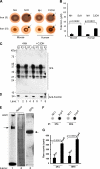
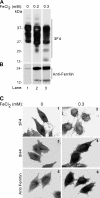
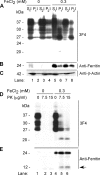
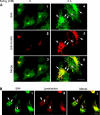
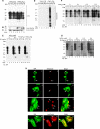
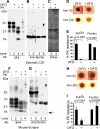
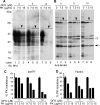
Similar articles
-
Abnormal brain iron homeostasis in human and animal prion disorders.PLoS Pathog. 2009 Mar;5(3):e1000336. doi: 10.1371/journal.ppat.1000336. Epub 2009 Mar 13. PLoS Pathog. 2009. PMID: 19283067 Free PMC article.
-
Pressure-assisted dissociation and degradation of "proteinase K-resistant" fibrils prepared by seeding with scrapie-infected hamster prion protein.Prion. 2014;8(4):314-8. doi: 10.4161/pri.32081. Prion. 2014. PMID: 25482603 Free PMC article.
-
The N-terminal, polybasic region of PrP(C) dictates the efficiency of prion propagation by binding to PrP(Sc).J Neurosci. 2012 Jun 27;32(26):8817-30. doi: 10.1523/JNEUROSCI.1103-12.2012. J Neurosci. 2012. PMID: 22745483 Free PMC article.
-
Prion diseases and emerging prion diseases.Curr Med Chem. 2008;15(9):912-6. doi: 10.2174/092986708783955437. Curr Med Chem. 2008. PMID: 18473798 Review.
-
Prion protein and metal interaction: physiological and pathological implications.Curr Issues Mol Biol. 2010;12(2):99-107. Epub 2009 Sep 18. Curr Issues Mol Biol. 2010. PMID: 19767653 Free PMC article. Review.
Cited by
-
Prion protein (PrP) knock-out mice show altered iron metabolism: a functional role for PrP in iron uptake and transport.PLoS One. 2009 Jul 1;4(7):e6115. doi: 10.1371/journal.pone.0006115. PLoS One. 2009. PMID: 19568430 Free PMC article.
-
Abnormal brain iron homeostasis in human and animal prion disorders.PLoS Pathog. 2009 Mar;5(3):e1000336. doi: 10.1371/journal.ppat.1000336. Epub 2009 Mar 13. PLoS Pathog. 2009. PMID: 19283067 Free PMC article.
-
Metal and complementary molecular bioimaging in Alzheimer's disease.Front Aging Neurosci. 2014 Jul 15;6:138. doi: 10.3389/fnagi.2014.00138. eCollection 2014. Front Aging Neurosci. 2014. PMID: 25076902 Free PMC article. Review.
-
The Iron Metabolism with a Specific Focus on the Functioning of the Nervous System.Biomedicines. 2024 Mar 6;12(3):595. doi: 10.3390/biomedicines12030595. Biomedicines. 2024. PMID: 38540208 Free PMC article. Review.
-
Prion protein modulates cellular iron uptake: a novel function with implications for prion disease pathogenesis.PLoS One. 2009;4(2):e4468. doi: 10.1371/journal.pone.0004468. Epub 2009 Feb 12. PLoS One. 2009. PMID: 19212444 Free PMC article.
References
-
- Aguzzi A., Polymendiou M. Mammalian prion biology: one century of evolving concepts. Cell. 2004;116:313–327. - PubMed
-
- Andreoletti O., Levavasseur E., Uro-Coste E., Tabouret G., Sarradin P., Delisle M. B., Berthon P., Salvayre R., Schelcher F., Negre-Salvayre A. Astrocytes accumulate 4-hydroxynonenal adducts in murine scrapie and human Creutzfeldt-Jakob disease. Neurobiol. Dis. 2002;11:386–393. - PubMed
-
- Behl C., Davis J. B., Lesley R., Schubert D. Hydrogen peroxide mediates amyloid beta protein toxicity. Cell. 1994;77:817–827. - PubMed
-
- Brazier M. W., et al. Correlative studies support lipid peroxidation is linked to PrP(res) propagation as an early primary pathogenic event in prion disease. Brain Res. Bull. 2006;68:346–354. - PubMed
Publication types
MeSH terms
Substances
Grants and funding
LinkOut - more resources
Full Text Sources
Other Literature Sources
Medical
Research Materials

